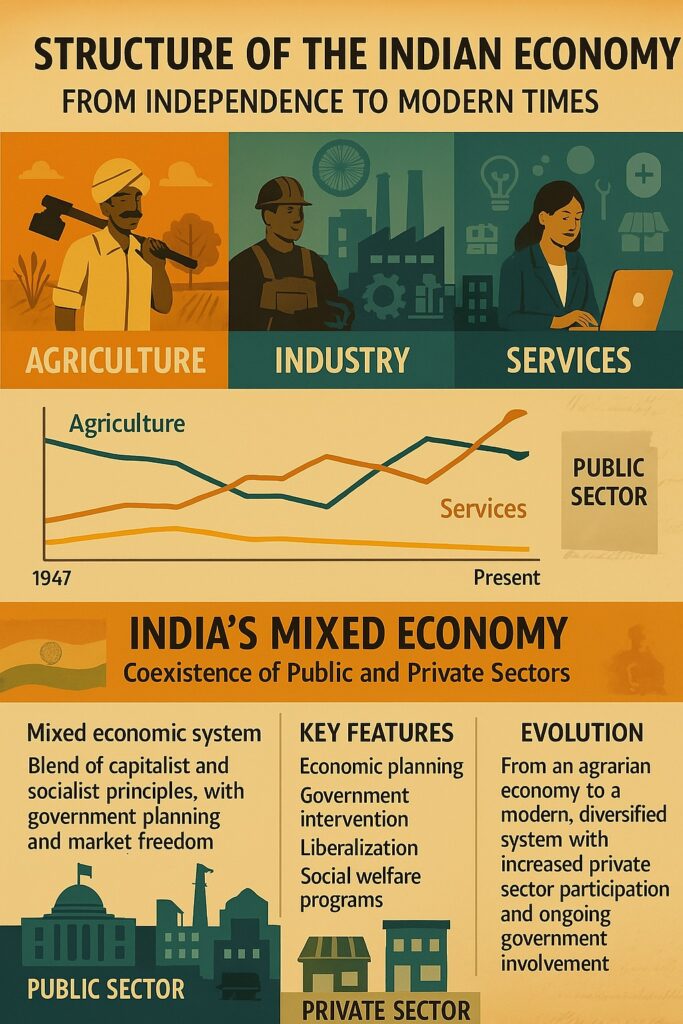The structure of an economy refers to the relative share and role of different sectors in generating income, employment, and overall development. In the case of India, the economy is characterised by a mixed economic system, with a combination of agriculture, industry, and services. The Indian economy has evolved significantly since independence in 1947, shifting from a largely agrarian base to a modern and diversified system.

Table of Contents
1. Basic Characteristics of the Indian Economy
- Mixed Economy: Coexistence of public and private sectors.
- Developing Economy: High population, low per capita income, and regional disparities.
- Dualistic Structure: Presence of both modern and traditional sectors (e.g., organised manufacturing and subsistence farming).
- Labour Abundance: High population engaged in informal and unorganised sectors.
- Resource Diversity: Rich in natural resources like coal, iron, rivers, and fertile plains.
2. Three Main Sectors of the Indian Economy
a) Primary Sector (Agriculture and Allied Activities)
- Involves extraction and use of natural resources.
- Includes agriculture, forestry, fishing, mining.
- Employs over 40% of the workforce (as per recent estimates).
- Contribution to GDP has declined to about 15–18%, showing a structural shift.
- Still vital for rural livelihoods and food security.
b) Secondary Sector (Industry and Manufacturing)
- Involves transformation of raw materials into finished goods.
- Includes manufacturing, construction, electricity, gas, and water supply.
- Employs around 25% of the workforce.
- Contribution to GDP: about 25–28%.
- Growth driven by small-scale industries, textiles, automobiles, pharmaceuticals, and steel.
c) Tertiary Sector (Services)
- Provides intangible goods like services, trade, education, transport, IT, banking, and tourism.
- Fastest growing sector in the Indian economy.
- Contributes over 50% to GDP.
- Employs around 35% of the workforce.
- India is a global leader in IT and business process outsourcing (BPO).
3. Structural Changes in the Indian Economy
Over the decades, India has undergone significant structural changes:
- Decline in agriculture’s share in GDP, but not in employment proportionately.
- Rise of services sector as the dominant contributor to GDP.
- Growth of urban centres driven by industrial and service activities.
- Expansion of informal sector, employing the majority of the workforce.
- Increased focus on industrial corridors, smart cities, and digital economy.
4. Challenges in the Structure
- Jobless growth: High GDP growth but low employment generation.
- Regional imbalance: Western and southern India more industrialised than eastern and central regions.
- Low agricultural productivity and rural distress.
- Overdependence on services with insufficient industrial base.
- Large informal/unorganised sector with low wages and no social security.
5. Government Initiatives
To address structural imbalances, several initiatives have been taken:
- Make in India – Boost manufacturing and exports.
- Digital India – Promote IT infrastructure and digital services.
- Skill India – Develop employable youth.
- PM Gati Shakti – Enhance infrastructure and logistics.
- Atmanirbhar Bharat – Encourage self-reliance and local production.
Conclusion
The structure of the Indian economy reflects its transition from an agrarian to a service-led economy, with industry playing an important intermediary role. Understanding this structure is essential for planning development strategies, addressing regional disparities, and ensuring inclusive and sustainable economic growth.
Read: Economy Notes